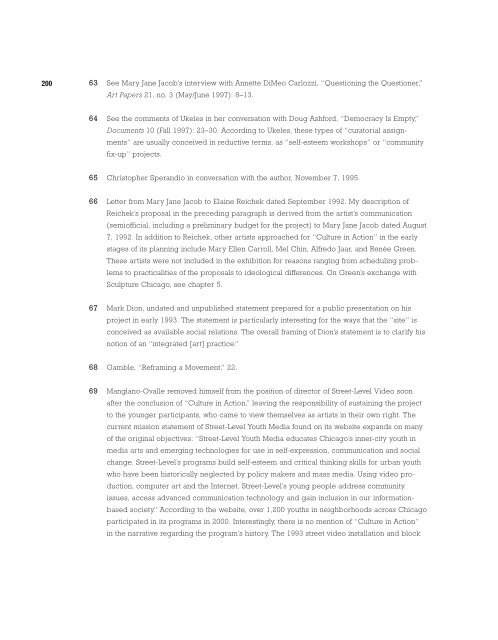ONE PLACE AFTER ANOTHER - Monoskop
ONE PLACE AFTER ANOTHER - Monoskop
ONE PLACE AFTER ANOTHER - Monoskop
Create successful ePaper yourself
Turn your PDF publications into a flip-book with our unique Google optimized e-Paper software.
200<br />
63 See Mary Jane Jacob’s interview with Annette DiMeo Carlozzi, “Questioning the Questioner,”<br />
Art Papers 21, no. 3 (May/June 1997): 8–13.<br />
64 See the comments of Ukeles in her conversation with Doug Ashford, “Democracy Is Empty,”<br />
Documents 10 (Fall 1997): 23–30. According to Ukeles, these types of “curatorial assign-<br />
ments” are usually conceived in reductive terms, as “self-esteem workshops” or “community<br />
fix-up” projects.<br />
65 Christopher Sperandio in conversation with the author, November 7, 1995.<br />
66 Letter from Mary Jane Jacob to Elaine Reichek dated September 1992. My description of<br />
Reichek’s proposal in the preceding paragraph is derived from the artist’s communication<br />
(semiofficial, including a preliminary budget for the project) to Mary Jane Jacob dated August<br />
7, 1992. In addition to Reichek, other artists approached for “Culture in Action” in the early<br />
stages of its planning include Mary Ellen Carroll, Mel Chin, Alfredo Jaar, and Renée Green.<br />
These artists were not included in the exhibition for reasons ranging from scheduling problems<br />
to practicalities of the proposals to ideological differences. On Green’s exchange with<br />
Sculpture Chicago, see chapter 5.<br />
67 Mark Dion, undated and unpublished statement prepared for a public presentation on his<br />
project in early 1993. The statement is particularly interesting for the ways that the “site” is<br />
conceived as available social relations. The overall framing of Dion’s statement is to clarify his<br />
notion of an “integrated [art] practice.”<br />
68 Gamble, “Reframing a Movement,” 22.<br />
69 Manglano-Ovalle removed himself from the position of director of Street-Level Video soon<br />
after the conclusion of “Culture in Action,” leaving the responsibility of sustaining the project<br />
to the younger participants, who came to view themselves as artists in their own right. The<br />
current mission statement of Street-Level Youth Media found on its website expands on many<br />
of the original objectives: “Street-Level Youth Media educates Chicago’s inner-city youth in<br />
media arts and emerging technologies for use in self-expression, communication and social<br />
change. Street-Level’s programs build self-esteem and critical thinking skills for urban youth<br />
who have been historically neglected by policy makers and mass media. Using video production,<br />
computer art and the Internet, Street-Level’s young people address community<br />
issues, access advanced communication technology and gain inclusion in our informationbased<br />
society.” According to the website, over 1,200 youths in neighborhoods across Chicago<br />
participated in its programs in 2000. Interestingly, there is no mention of “Culture in Action”<br />
in the narrative regarding the program’s history. The 1993 street video installation and block

















